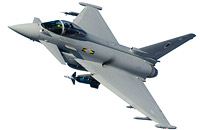Eurofighter Typhoon (EF2000)
Role: multi-role fighter
Builder: Eurofighter Jagdflugzeug GmbH :
BAE Systems (formerly British Aerospace),
Airbus Defence & Space (EADS-Cassidian and EADS-CASA, formerly DASA and CASA),
Finmeccanica/Alenia Aermacchi (formerly Alenia, Aeritalia)
Variants: DA, IPA, Tranche 1, Tranche 2, (Tranche 3)
RAF designations T.1/T.1A/T.3 two-seat aircraft, F.2/FGR.4 single-seat aircraft
Operators: United Kingdom, Germany, Italy, Spain,
Austria, Kuwait (2019), Saudi Arabia, Oman (2017)
this section provides a brief summary
see the Eurofighter Typhoon related news page for the latest details
The Eurofighter program started back in 1992. In 1994 the first prototype DA-1 made its maiden flight. The current Eurofighter design has been named Typhoon by the Royal Air Force, dropping the EF2000 project name that's still used by Germany to refer to the jets. Spain and Italy as well as the industry have taken on the Typhoon as well in addition to their own designations (C.16 and F-2000 respectively). Seven Development Aircraft (DA) were built, as well as seven Instrumented Production Aircraft (IPA) for evaluation, weapons and systems testing, and development of updates, before series production in three tranches. Currently Tranche 2 aircraft are delivered, with Tranche 1 aircraft being cycled back for updates, Tranche 3 has been split in two runs. 3A is in full production, and the first Tranche 3A aircraft was rolled out in late 2013. The final production run designated Tranche 3B has been planned to introduce new capabilities, and is under development. Lowering the production rate of Tranche 3A, Tranche 3B has been delayed.
The design features a delta wing design with canards set well forward of the wing. These features combined with two powerful EJ200 engines and digital flight control systems produce a highly agile fighter. Suited with the latest technology and avionics and its multi-role capabilities make the Eurofighter a true fourth generation combat aircraft.
A total production of 620 aircraft have been agreed by the participating countries, although cuts have been made to the Tranche 3 production. Production and deliveries are well under way now, with all Tranche 1 orders being fulfilled. Delivered aircraft are being upgraded to the latest Tranche 1 production standard, Block 5, to bring all Tranche 1 aircraft to a near-common standard, including limited air-to-ground capability with a selection of precision guided weapons. Thus far exports are fulfilled using the redirection of production aircraft destined to the partnering nations, additionally second-hand aircraft from Tranche 1 are offered on the international market.
The RAF is primarily replacing the Tornado F.3 air defence fighters, but has also retired its remaining
Jaguar fighter-bombers. The Tranche 1 aircraft were initially designated T.1 for the two-seater, and F.2 for the single-seater.
Since adding an initial air-to-surface capability from Block 5 among other improvements, the designation FGR.4 was adopted for the single-seaters
and two-seaters have adopted the T.3 designation. The T.1/F.2 aircraft upgraded to Block 5 standard also adopt the new designations.
The Eurofighters for the Luftwaffe replaced the F-4F Phantom IIs in the air defense role
(and fill the gap left by the retirement of the MiG-29 Fulcrum-C), and will gradually take-over the air-to-surface role of the Tornado IDS.
Italy retired its last F-104ASA Starfighters
and returned the leased RAF Tornado F.3s before Eurofighters were delivered in sufficient numbers. Because of the delays in the program, Italy had to lease
ex-USAF F-16 ADF to fill the gap. Having equipped its third wing with the Typhoon, designated F-2000 in Italian service, the leased F-16s returned to the US in 2011-2012.
After Spain equipped its first squadron with the Eurofighter, part of the Mirage F1 fleet was put through a
modernisation program to keep them in service during the Eurofighter deliveries until withdrawn in 2013.
Eurofighter GmbH is trying to market the Eurofighter Typhoon abroad but had only minor success. It has strong competition from the US led Joint Strike Fighter (JSF) program, the French Dassault Rafale, F-16 Block60, Saab Gripen, Sukhoi Su-30 and Su-35 variants, F/A-18E/F Super Hornet, Mirage 2000-5 Mk.2 and Boeing's advanced F-15 variants.
Although Greece was the first to
sign a contract for delivery of a first batch of Eurofighters, having initially ordered 60 aircraft with
an option for 30 more, the contract was cancelled.
Austria ordered 18 Eurofighter Typhoons, with an option for six more, the contract was revised in 2007
and the number was reduced to 15 aircraft of Tranche 1 standard from the production run for Germany.
Saudi Arabia signed a declaration of understanding with regards to the purchase of
24 Typhoons in Tranche 2 standard to replace its Tornado ADV fleet. The initial order came from Britain's Tranche 2 production.
Additional batches are following as Saudi Arabia has a requirement for at least 72 Typhoons. Although initially it was planned
to have the next 48 Typhoon final assembly in Saudi Arabia, it was decided to not go ahead with plans for a local production facility.
The latest customer is Oman with only 12 aircraft on order, which may be coming from allotted UK production.
The German Tranche 3B production lot is also to be sold to another customer, while Italy's Tranche 3B production lot is also uncertain
to materialize in deliveries to the Italian Air Force.

Development Aircraft 1

Development Aircraft 1

Development Aircraft 4 and 2

Instrumented Production Aircraft 1


 Back to Index
Back to Index